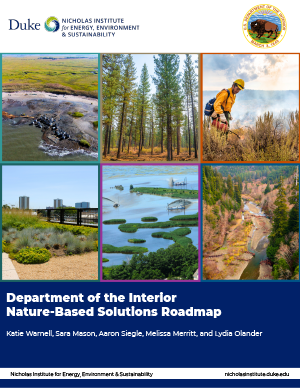Roadmap Points the Way for Federal Department’s Use of Nature-Based Solutions
A Duke University team collaborated with the Department of the Interior to produce a practical, comprehensive resource on implementing nature-based solutions.
An online resource created by Duke University experts and students will support efforts by the largest manager of public lands in the United States to protect, sustainably manage and restore these lands in ways that benefit both people and nature.
Working closely with the Department of the Interior (DOI), the Nicholas Institute for Energy, Environment & Sustainability developed the DOI Nature-Based Solutions Roadmap to provide DOI staff with consistent and credible information for implementing nature-based solutions. Assistant Secretary for Fish and Wildlife and Parks Shannon Estenoz announced the Roadmap on Saturday during a U.S.-led event on nature-based solutions at the 28th Conference of the Parties (COP28) of the United Nations Framework Convention on Climate Change, taking place in Dubai.
Nature-based solutions cited in the Roadmap range from urban stormwater and runoff management to prescribed burns to living shorelines to restoration of various ecosystems.
“The Department of the Interior is responsible for a vast, diverse array of lands and waters, positioning it well to help meet federal conservation efforts,” said lead author Katie Warnell, a senior policy associate at the Nicholas Institute. “While DOI already uses many of the strategies included in the Roadmap, these projects are not always designed using a nature-based solutions framing. The approaches and information in the Roadmap can help expand value to both people and nature.”
DOI manages more than 480 million acres of federal lands, plus tribal lands, marine national monuments and the Outer Continental Shelf.
While each project that utilizes a nature-based solution requires planning and design specific to the site and the strategy being employed, some principles and considerations apply in every case. The first section of the Roadmap offers information on these cross-cutting principles and considerations, including community engagement, application of Indigenous Knowledges, equity and environmental justice, funding sources and common barriers.
The bulk of the nearly 500-page Roadmap is devoted to details about 29 individual nature-based solutions strategies. Each strategy summary contains these elements:
- A list of likely benefits, including climate threat reduction, socioeconomic and ecological benefits
- Links to additional tools, training and resources for project planning, implementation and monitoring
- Example projects from throughout the United States
- Details about site suitability, how the strategy is implemented on the ground and operations and maintenance needs
Three Nicholas Institute experts in nature-based solutions—Warnell, Sara Mason and Lydia Olander—spent months collaborating on the Roadmap with personnel at several DOI bureaus. Two Duke students also had a key role in preparing the individual strategies: Melissa Merritt, a master of environmental management student at the Nicholas School of the Environment, and Aaron Siegle, an undergraduate planning to major in environmental science.
Even after publication, the Duke team’s work will continue—the Roadmap is a living document that will be periodically updated to include new information. And while this resource is intended primarily for a DOI audience, others can draw from it.
“Support for nature-based solutions is growing rapidly across the United States as a way to improve the resilience of our communities and ecosystems,” said Olander, program director at the Nicholas Institute. “We hope that others can utilize the Roadmap as they work to build more resilient landscapes, watersheds, and communities.”
Nature-Based Solutions at Duke
The Roadmap is the latest example of a growing body of work by Duke experts to advance nature-based solutions.
Several Nicholas Institute efforts have sought to identify opportunities to implement nature-based solutions projects, understand and measure their benefits for people and ecosystems, and provide relevant planning and communications resources for natural resource managers. Most recently, a working group led by the Nicholas Institute and Environmental Policy Innovation Center launched a project aimed at providing resources for scaling up financing of nature-based solutions through green banks and community lenders.
For the last two years, Olander spent much of her time on loan from Duke to the White House Council on Environmental Quality, where she served as director of nature-based resilience. She returns to Duke full-time this month.
In September, the university joined the Network for Engineering With Nature, an active community of researchers, practitioners and educators who are addressing major infrastructure challenges in the United States through “Engineering With Nature®.” The Nicholas Institute for Energy, Environment & Sustainability is leading Duke’s involvement in the network, working with faculty, staff and students across the university, including at the Nicholas School of the Environment and Pratt School of Engineering.
Duke schools and institutes are engaged in many other ongoing projects and initiatives related to nature-based solutions, including Duke Restore, Duke Wetland Center, The Climate-Plant Innovation Network, National Ecosystem Services Partnership and the North Carolina Ecosystem Technology.
Questions?
Contact Katie Warnell at the Nicholas Institute.





